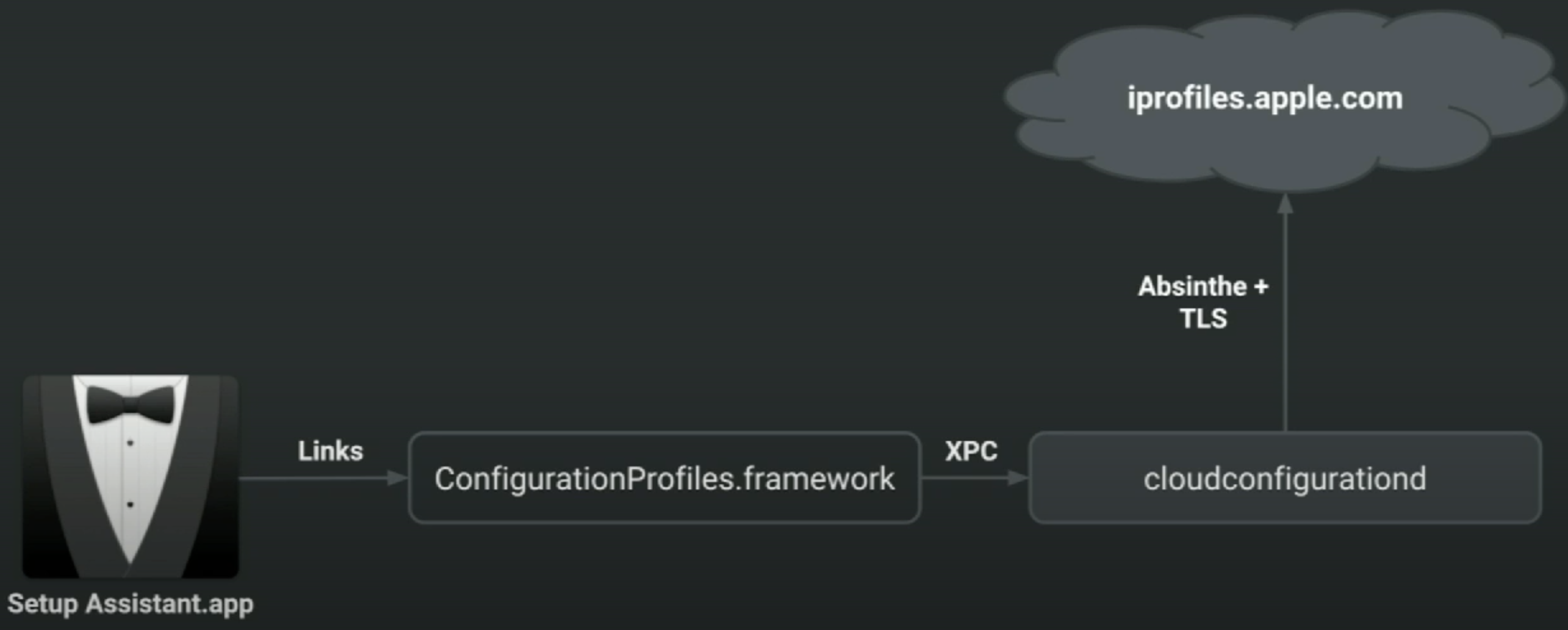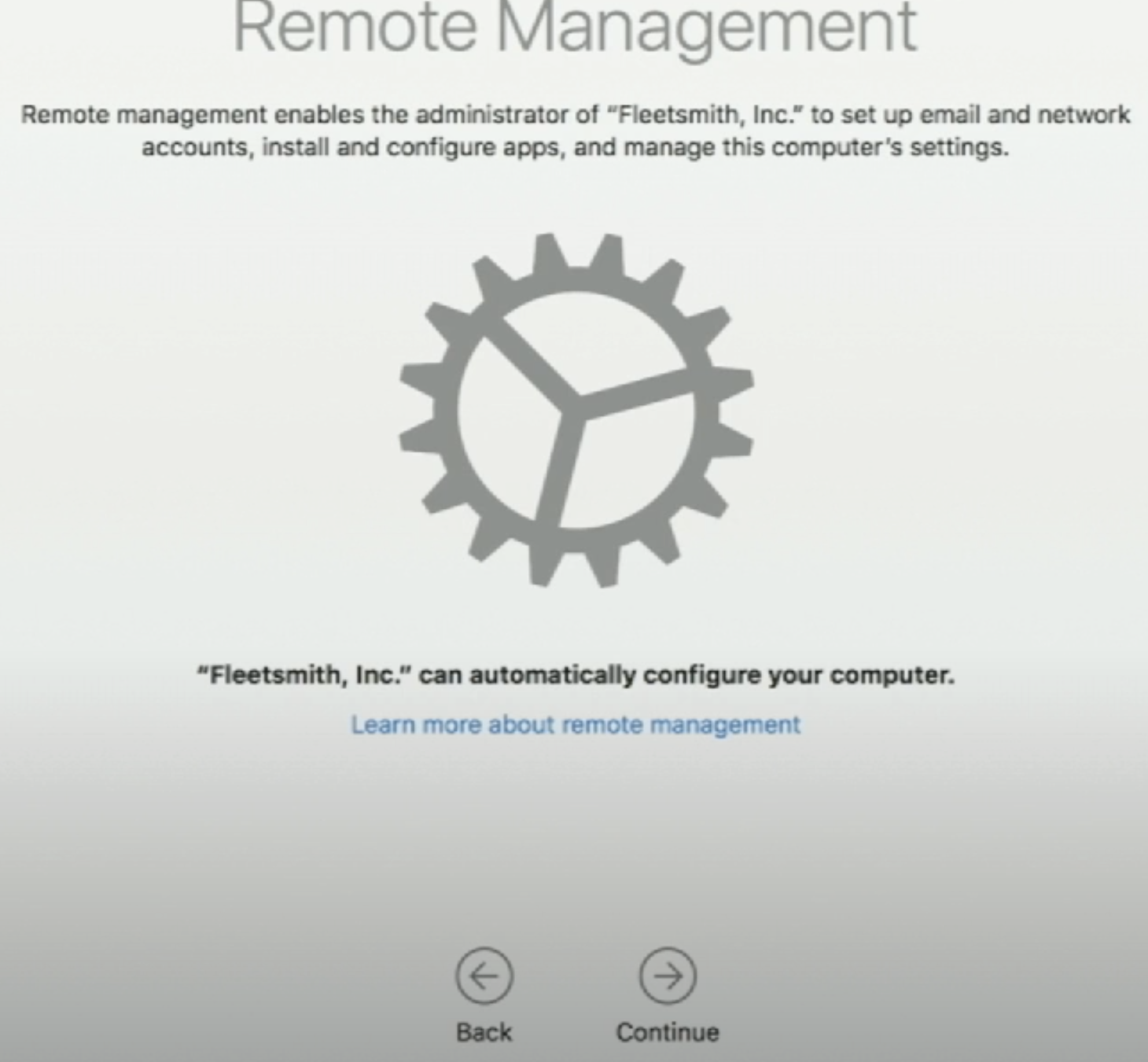mirror of
https://github.com/carlospolop/hacktricks
synced 2024-11-22 20:53:37 +00:00
7.7 KiB
7.7 KiB
MacOS MDM
Basics
What is MDM Mobile Device Management?
- A way to achieve centralized device management
- Requires an MDM server which implements support for the MDM protocol
- MDM server can send MDM commands, such as remote wipe or “install this config”
Basics What is DEP Device Enrolment Program?
- Allows a device to automatically enroll in pre-configured MDM server the first time it’s powered on
- Most useful when the device is brand new
- Can also be useful for reprovisioning workflows
**wiped** with fresh install of the OS
Basics What is SCEP Simple Certificate Enrolment Protocol?
- A relatively old protocol, created before TLS and HTTPS were widespread.
- Gives clients a standardized way of sending a Certificate Signing Request
CSRfor the purpose of being granted a certificate. The client will ask the server to give him a signed certificate.
What are Configuration Profiles aka mobileconfigs?
- Apple’s official way of setting/enforcing system configuration.
- File format that can contain multiple payloads.
- Based on property lists
the XML kind. - “can be signed and encrypted to validate their origin, ensure their integrity, and protect their contents.” Basics — Page 70, iOS Security Guide, January 2018.
Protocols
MDM
- Combination of APNs
**Apple server**s+ RESTful API**MDM** **vendor** servers - Communication occurs between a device and a server associated with a device management product
- Commands delivered from the MDM to the device in plist-encoded dictionaries
- All over HTTPS. MDM servers can be
and are usuallypinned. - Apple grants the MDM vendor an APNs certificate for authentication
DEP
- 3 APIs: 1 for resellers, 1 for MDM vendors, 1 for device identity
undocumented - More modern and JSON based
vs. plist - Apple grants an OAuth token to the MDM vendor
DEP "cloud service" API
- RESTful
- sync device records from Apple to the MDM server
- sync “DEP profiles” to Apple from the MDM server
delivered by Apple to the device later on - A DEP “profile” contains:
- MDM vendor server URL
- Additional trusted certificates for server URL
optional pinning - Extra settings
e.g. which screens to skip in Setup Assistant
Steps for enrolment and management
- Device record creation
Reseller, Apple: The record for the new device is created - Device record assignment
Customer: The device is assigned to a MDM server - Device record sync
MDM vendor: MDM sync the device records and push the DEP profiles to Apple - DEP check-in
Device: Device gets his DEP profile - Profile retrieval
Device - Profile installation
Devicea. incl. MDM, SCEP and root CA payloads - MDM command issuance
Device
The file /Library/Developer/CommandLineTools/SDKs/MacOSX10.15.sdk/System/Library/PrivateFrameworks/ConfigurationProfiles.framework/ConfigurationProfiles.tbd exports functions that can be considered high-level "steps" of the enrolment process.
Step 4: DEP check-in - Getting the Activation Record
This part of the process occurs when a user boots a Mac for the first time or after a complete wipe
or when executing sudo profiles show -type enrollment
- Determine whether device is DEP enabled
- Activation Record is the internal name for DEP “profile”
- Begins as soon as the device is connected to Internet
- Driven by
CPFetchActivationRecord - Implemented by
cloudconfigurationdvia XPC. The "Setup Assistant"when the device is firstly bootedor theprofilescommand will contact this daemon to retrieve the activation record.- LaunchDaemon
always runs as root
- LaunchDaemon
It follows a few steps to get the Activation Record performed by MCTeslaConfigurationFetcher. This process uses an encryption called Absinthe
- Retrieve certificate
- Initialize state from certificate
**`NACInit`**- Uses various device-specific data
i.e. **Serial Number via `IOKit`**
- Uses various device-specific data
- Retrieve session key
- Establish the session
**`NACKeyEstablishment`** - Make the request
- POST to https://iprofiles.apple.com/macProfile sending the data
{ "action": "RequestProfileConfiguration", "sn": "" } - The JSON payload is encrypted using Absinthe
**`NACSign`** - All requests over HTTPs, built-in root certificates are used
- POST to https://iprofiles.apple.com/macProfile sending the data
The response is a JSON dictionary with some important data like:
- url: URL of the MDM vendor host for the activation profile
- anchor-certs: Array of DER certificates used as trusted anchors
Step 5: Profile Retrieval
- Request sent to url provided in DEP profile.
- Anchor certificates are used to evaluate trust if provided.
- Reminder: the anchor_certs property of the DEP profile
- Request is a simple .plist with device identification
- Examples: UDID, OS version.
- CMS-signed, DER-encoded
- Signed using the device identity certificate (from APNS)
- Certificate chain includes expired Apple iPhone Device CA
Step 6: Profile Installation
- Once retrieved, profile is stored on the system
- This step begins automatically
if in **setup assistant** - Driven by
CPInstallActivationProfile - Implemented by mdmclient over XPC
- LaunchDaemon
as rootor LaunchAgentas user, depending on context
- LaunchDaemon
- Configuration profiles have multiple payloads to install
- Framework has a plugin-based architecture for installing profiles
- Each payload type is associated with a plugin
- Can be XPC
in frameworkor classic Cocoain ManagedClient.app
- Can be XPC
- Example:
- Certificate Payloads use CertificateService.xpc
Typically, activation profile provided by an MDM vendor will include the following payloads:
com.apple.mdm: to enroll the device in MDMcom.apple.security.scep: to securely provide a client certificate to the device.com.apple.security.pem: to install trusted CA certificates to the device’s System Keychain.- Installing the MDM payload equivalent to MDM check-in in the documentation
- Payload contains key properties:
-
- MDM Check-In URL
**`CheckInURL`** - MDM Command Polling URL
**`ServerURL`**+ APNs topic to trigger it
- MDM Check-In URL
- To install MDM payload, request is sent to
CheckInURL - Implemented in
mdmclient - MDM payload can depend on other payloads
- Allows requests to be pinned to specific certificates:
- Property:
CheckInURLPinningCertificateUUIDs - Property:
ServerURLPinningCertificateUUIDs - Delivered via PEM payload
- Property:
- Allows device to be attributed with an identity certificate:
- Property: IdentityCertificateUUID
- Delivered via SCEP payload
Step 7: Listening for MDM commands
- After MDM check-in is complete, vendor can issue push notifications using APNs
- Upon receipt, handled by
mdmclient - To poll for MDM commands, request is sent to ServerURL
- Makes use of previously installed MDM payload:
ServerURLPinningCertificateUUIDsfor pinning requestIdentityCertificateUUIDfor TLS client certificate




